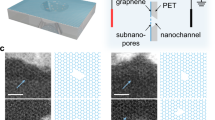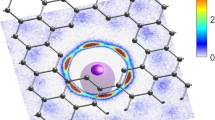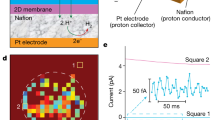Abstract
The ability to tune ionic permeation across nanoscale pores profoundly impacts diverse fields from nanofluidic computing to drug delivery. Here, we take advantage of complex formation between crown ethers and dissolved metal ions to demonstrate graphene-based ion channels highly sensitive to externally applied lattice strain. We perform extensive room-temperature molecular dynamics simulations of the effects of tensile lattice strain on ion permeation across graphene-embedded crown ether pores. Our findings suggest the first instance of solid-state ion channels with an exponential permeation sensitivity to strain, yielding an order of magnitude ion current increase for 2% of isotropic lattice strain. Significant permeation tuning is also shown to be achievable with anisotropic strains. Finally, we demonstrate strain-controllable ion sieving in salt mixtures. The observed high mechanosensitivity is shown to arise from strain-induced control over the competition between ion–crown and ion–solvent interactions, mediated by the atomic thinness of graphene.
This is a preview of subscription content, access via your institution
Access options
Access Nature and 54 other Nature Portfolio journals
Get Nature+, our best-value online-access subscription
$29.99 / 30 days
cancel any time
Subscribe to this journal
Receive 12 print issues and online access
$259.00 per year
only $21.58 per issue
Buy this article
- Purchase on Springer Link
- Instant access to full article PDF
Prices may be subject to local taxes which are calculated during checkout





Similar content being viewed by others
Data availability
The data sets generated and analysed in this study are available from the corresponding author upon reasonable request.
References
Nam, S.-W. et al. Ionic field effect transistors with sub-10 nm multiple nanopores. Nano Lett. 9, 2044–2048 (2009).
Joshi, P. et al. Field effect modulation of ionic conductance of cylindrical silicon-on-insulator nanopore array. J. Appl. Phys. 107, 054701 (2010).
Humplik, T. et al. Nanostructured materials for water desalination. Nanotechnology. 22, 292001 (2011).
Höltzel, A. & Tallarek, U. Ionic conductance of nanopores in microscale analysis systems: where microfluidics meets nanofluidics. J. Sep. Sci. 30, 1398–1419 (2007).
Schoch, R. B., Han, J. & Renaud, P. Transport phenomena in nanofluidics. Rev. Mod. Phys. 80, 839–883 (2008).
Duan, R., Xia, F. & Jiang, L. Constructing tunable nanopores and their application in drug delivery. ACS Nano 7, 8344–8349 (2013).
Catterall, W. A. Structure and function of voltage-gated ion channels. Annu. Rev. Biochem. 64, 493–531 (1995).
Tasneem, A. et al. Identification of the prokaryotic ligand-gated ion channels and their implications for the mechanisms and origins of animal Cys-loop ion channels. Genome Biol. 6, R4–R4 (2005).
Chowdhury, S., Jarecki, B. W. & Chanda, B. A molecular framework for temperature-dependent gating of ion channels. Cell 158, 1148–1158 (2014).
Martinac, B. Mechanosensitive ion channels: molecules of mechanotransduction. J. Cell Sci. 117, 2449–2460 (2004).
Kasianowicz, J. J. et al. Characterization of individual polynucleotide molecules using a membrane channel. Proc. Natl Acad. Sci. USA 93, 13770–13773 (1996).
Dekker, C. Solid-state nanopores. Nat. Nanotech. 2, 209–215 (2007).
Wang, L. et al. Fundamental transport mechanisms, fabrication and potential applications of nanoporous atomically thin membranes. Nat. Nanotech. 12, 509–522 (2017).
Pedersen, C. J. Cyclic polyethers and their complexes with metal salts. J. Am. Chem. Soc. 89, 2495–2496 (1967).
Glendening, E. D., Feller, D. & Thompson, M. A. An ab initio investigation of the structure and alkali metal cation selectivity of 18-crown-6. J. Am. Chem. Soc. 116, 10657–10669 (1994).
Izatt, R. M. et al. Calorimetric titration study of the interaction of several uni- and bivalent cations with 15-crown-5, 18-crown-6, and two isomers of dicyclohexo-18-crown-6 in aqueous solution at 25 °C and μ = 0.1. J. Am. Chem. Soc. 98, 7620–7626 (1976).
Inokuchi, Y. et al. Ion selectivity of crown ethers investigated by UV and IR spectroscopy in a cold ion trap. J. Phys. Chem. A 116, 4057–4068 (2012).
Gokel, G. W., Leevy, W. M. & Weber, M. E. Crown ethers: sensors for ions and molecular scaffolds for materials and biological models. Chem. Rev. 104, 2723–2750 (2004).
Guo, J. et al. Crown ethers in graphene. Nat. Commun. 5, 5389 (2014).
Gaikwad, A. G., Noguchi, H. & Yoshio, M. Stability constants of crown ether complexes with aqueous hydronium ion. Anal. Sci. 3, 217–220 (1987).
Smolyanitsky, A., Paulechka, E. & Kroenlein, K. Aqueous ion trapping and transport in graphene-embedded 18-crown-6 ether pores. ACS Nano 12, 6677–6684 (2018).
Fasolino, A., Los, J. H. & Katsnelson, M. I. Intrinsic ripples in graphene. Nat. Mater. 6, 858–861 (2007).
Gordillo, M. C. & Martí, J. Structure of water adsorbed on a single graphene sheet. Phys. Rev. B 78, 075432 (2008).
Nelson, P. H. A permeation theory for single-file ion channels: one- and two-step models. J. Chem. Phys. 134, 165102 (2011).
Rawicz, W. et al. Effect of chain length and unsaturation on elasticity of lipid bilayers. Biophys. J. 79, 328–339 (2000).
Androulidakis, C. et al. Experimentally derived axial stress–strain relations for two-dimensional materials such as monolayer graphene. Carbon 81, 322–328 (2015).
Horn, H. W. et al. Development of an improved four-site water model for biomolecular simulations: TIP4P-Ew. J. Chem. Phys. 120, 9665–9678 (2004).
Noskov, S. Y., Bernèche, S. & Roux, B. Control of ion selectivity in potassium channels by electrostatic and dynamic properties of carbonyl ligands. Nature 431, 830 (2004).
Moreno, C. et al. Bottom-up synthesis of multifunctional nanoporous graphene. Science 360, 199–203 (2018).
Goldsche, M. et al. Tailoring mechanically tunable strain fields in graphene. Nano Lett. 18, 1707–1713 (2018).
Cretu, O. et al. Structure and local chemical properties of boron-terminated tetravacancies in hexagonal boron nitride. Phys. Rev. Lett. 114, 075502 (2015).
Feng, J. et al. Electrochemical reaction in single layer MoS2: nanopores opened atom by atom. Nano Lett. 15, 3431–3438 (2015).
Thiruraman, J. P. et al. Angstrom-size defect creation and ionic transport through pores in single-layer MoS2. Nano Lett. 18, 1651–1659 (2018).
Smolyanitsky, A. Molecular dynamics simulation of thermal ripples in graphene with bond-order-informed harmonic constraints. Nanotechnology 25, 485701 (2014).
Paulechka, E. et al. Nucleobase-functionalized graphene nanoribbons for accurate high-speed DNA sequencing. Nanoscale 8, 1861–1867 (2016).
Jorgensen, W. L., Maxwell, D. S. & Tirado-Rives, J. Development and testing of the OPLS all-atom force field on conformational energetics and properties of organic liquids. J. Am. Chem. Soc. 118, 11225–11236 (1996).
Perdew, J. P., Burke, K. & Ernzerhof, M. Generalized gradient approximation made simple. Phys. Rev. Lett. 77, 3865–3868 (1996).
Hartwigsen, C., Goedecker, S. & Hutter, J. Relativistic separable dual-space Gaussian pseudopotentials from H to Rn. Phys. Rev. B 58, 3641–3662 (1998).
VandeVondele, J. & Hutter, J. Gaussian basis sets for accurate calculations on molecular systems in gas and condensed phases. J. Chem. Phys. 127, 114105 (2007).
Grimme, S. et al. A consistent and accurate ab initio parametrization of density functional dispersion correction (DFT-D) for the 94 elements H-Pu. J. Chem. Phys. 132, 154104 (2010).
Hutter, J. et al. cp2k: atomistic simulations of condensed matter systems. WIRES Comput. Mol. Sci. 4, 15–25 (2014).
Van Der Spoel, D. et al. Gromacs: fast, flexible, and free. J. Comput. Chem. 26, 1701–1718 (2005).
Hess, B. et al. Gromacs 4: algorithms for highly efficient, load-balanced, and scalable molecular simulation. J. Chem. Theory. Comput. 4, 435–447 (2008).
Hub, J. S., de Groot, B. L. & van der Spoel, D. g_wham—a free weighted histogram analysis implementation including robust error and autocorrelation estimates. J. Chem. Theory Comput. 6, 3713–3720 (2010).
Acknowledgements
The authors thank M. Zwolak for suggesting lattice strain as a potential way of controlling permeation, E. Paulechka for enlightening discussions about defects and competitive permeation, and A. Bazyleva for discussions about the chemistry of crown ethers. This research was performed while A. Fang held a National Research Council Postdoctoral Research Associateship at the National Institute of Standards and Technology. The authors acknowledge support from the Materials Genome Initiative.
Author information
Authors and Affiliations
Contributions
A.S. designed and performed the simulations, and developed the theory. A.F. and K.K. devised and implemented analysis software. A.F. and D.R. contributed to the theory. All authors discussed the results, wrote the manuscript and contributed to revisions.
Corresponding author
Ethics declarations
Competing interests
The authors declare no competing interests.
Additional information
Publisher’s note: Springer Nature remains neutral with regard to jurisdictional claims in published maps and institutional affiliations.
Supplementary information
Supplementary Information
Supplementary Sections 1–4, Supplementary Figures 1–6, Supplementary References 1–6
Rights and permissions
About this article
Cite this article
Fang, A., Kroenlein, K., Riccardi, D. et al. Highly mechanosensitive ion channels from graphene-embedded crown ethers. Nature Mater 18, 76–81 (2019). https://doi.org/10.1038/s41563-018-0220-4
Received:
Accepted:
Published:
Issue Date:
DOI: https://doi.org/10.1038/s41563-018-0220-4
This article is cited by
-
Scaling of ionic conductance in a fluctuating single-layer nanoporous membrane
Scientific Reports (2023)
-
Mechanism of Li+/Na+ separation by crown ether and butyrate acid root
Rare Metals (2023)
-
Origin and control of ionic hydration patterns in nanopores
Communications Materials (2021)
-
Single-File Water Flux Through Two-Dimensional Nanoporous Membranes
Nanoscale Research Letters (2020)
-
Towards artificial mechanosensing
Nature Materials (2020)



